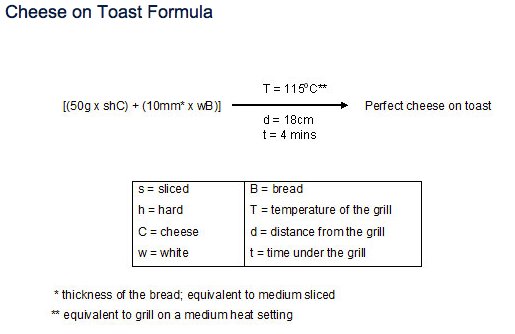
The Royal Society of Chemistry and the British Cheese Board applied the scientific method to determine optimum “process parameters” for making cheese on toast, a favorite snack of UK children and inspire school-age children to consider STEM careers. A deeper question, though: how urgent is the need for new STEM-trained graduates? Credit: RSC.
By today, the vast majority of school-age children in the US and most of the Northern Hemisphere will be in school for another round of prescribed instruction in reading, writing, and arithmetic. The experience of starting a new school year is familiar to CTT readers, many of whom can claim nearly two decades of schooling.
Omnipresent on K–12 curricula is the “scientific method,” which most of our readers use in their professional work. In the best of back-to-school traditions, here is a quick review of the scientific method from sciencebuddies.org. (SB is a nonprofit offering K–12 science projects.)
- Ask a question
- Do background research
- Construct a hypothesis
- Test your hypothesis by doing an experiment
- Analyze your data and draw a conclusion
- Communication your results.
Sound familiar? The next challenge is to teach the scientific method effectively, and in this regard there are plenty of products and options available. But, it is hard to beat a simple demonstration that relates to youngsters’ experiences to trigger the “Aha!” moment.
For simplicity and effectiveness, look no further than a recent collaboration between the Royal Society of Chemistry in the UK and the British Cheese Board to determine the optimum parameters for making cheese on toast. Apparently a long-time favorite snack of kids in the UK, it is made by toasting a slice of bread in an oven, then flipping it over, topping with cheese, and grilling to the “perfect” level of meltiness.
Back in June the BCB embarked on a quest to find the perfect recipe for cheese on toast. The organization turned to Ruth Neale, a chemist and Science Executive at the RSC, to apply some scientific rigor to the evaluation.
In a RSC press release she explains how she applied scientific principles to the evaluation: “…we carried out a series of tests on the grilling conditions, changing just one variable at a time—just as a scientist would carry out tests in the lab (emphasis added).” Three properties were evaluated: temperature uniformity of the the molten cheese, cheese texture, and taste. Applying the scientific method, Neale systematically varied distance from the heat source, toasting time, and form of the cheese (i.e., shredded, cubed, and sliced). You can see several images of Neale at work on this food blog.
After optimizing the “process parameters,” Neale worked with BCB cheese expert Nigel White to find the best bread-and-cheese combination. Their specification for the perfect snack? A 50 gram slice of hard cheddar-like cheese on 10 mm thick white bread, toasted to a cheese temperature of 115°C (18 cm from the heat in the RSC kitchen) for four minutes. In true scientific form, Neale and White reduce their findings to the formula above. Pure elegance.
Young, smart, engaging, and obviously passionate about science, Neale could be a poster-child for the STEM (science, technology, education, and mathematics) education movement. She is frank about the cheese on toast project’s ulterior motive to inspire future scientists and engineers. She says in the press release, “…we hope that the tests we carried out to determine our formula demonstrates the approach scientists take to designing experiments for their research.”
We hear a lot about the importance of developing the STEM workforce, and some funding agencies such as the NSF have been proactive and effective not only in promoting STEM careers, but also in attracting diverse and underrepresented populations to STEM careers. The underlying assumption, though, is that STEM careers must be promoted to meet expected demand.
A recent essay published on the IEEE website challenges the premise that the world is in danger of there being too few scientists, engineers, and mathematicians. I’m not going to take a side, but rather will pull a few highlights from Robert Charette’s very well researched essay, “The STEM Crisis is a Myth.” It is packed with links back to his sources and worth the time to read.
Charette observes that several countries are sounding the alarm that there are not enough STEM graduates. In the US, the President’s Council of Advisors on Science and Technology (the august body that first recommended the Materials Genome Initiative) in a 2012 report claims that one million STEM graduates will be needed. Similar councils are making similar claims in the UK, Germany, Japan, India, Brazil, and South Africa.
One problem, according to Charette, is that defining exactly what comprises a STEM job is complicated. Take my job, for example. As it happens, I have a BS and MS STEM degree and serve a STEM audience. Does that make my job a STEM job?
STEM headcounts by federal agencies do not agree, either. The Department of Commerce says 7.6 million worked in STEM jobs in 2010, but the NSF counted 12.4 million. Charette also points out that many with STEM credentials do not work in STEM careers. Turning again to Commerce statistics, he says up to 75% of STEM-degreed workers work outside of STEM careers. Maybe that is the box I fit into?
Charette considers the claim that there is a STEM talent dearth and concludes that supporting evidence is fuzzy. Maybe there is a workforce shortfall, but maybe there isn’t. He quotes a 2012 NSF workforce study, “Projections of employment growth are plagued by uncertain assumptions and are notoriously difficult to make.”
For perspective and insight, Charette turns to public policy and law scholars who have studied the issue. One aspect mentioned is the cyclic nature of the demand for STEM grads, which is called “alarm, boom, and bust.” Many of us have experienced the cycle—for example, I graduated in the 1982 “bust” phase of the cycle. According to Charette’s experts, we are in the “alarm” phase of the current cycle and entering the “boom” phase. It is not known when the next “bust” phase will come back around.
Today STEM intersects with daily life at every moment. To be a citizen of the world requires a certain comfort level with STEM principles. Not far from where I live, for example, residents will have to decide whether to allow natural gas recovery by hydraulic fracturing. This will require them to evaluate various claims about water chemistry, earth science, environmental science, etc. What it means, according to Charette, is that “everyone needs a solid grounding in science, engineering, and math. In that sense, there is indeed a shortage—a STEM knowledge shortage.”
That goes the other way, too, and he argues that STEM students are not excused—nor should they want to be—from building a firm foundation in the liberal arts such as history, literature, music, and culture. He quotes Norman Augustine, now retired as chairman and CEO of Lockheed Martin and an engineer by training, who said in a Wall Street Journal op-ed piece in 2011, “In my position as CEO of a firm employing over 80,000 engineers, I can testify that most were excellent engineers. But the factor that most distinguished those who advanced in the organization was the ability to think broadly and read and write clearly.”
Charette’s essay offers plenty more to think about and is eminently readable. He does a great job digging up statistics, reports, and experts. I suggest you read it whilst enjoying a perfect cheese on toast.

